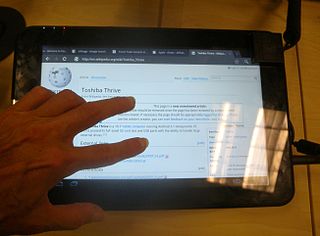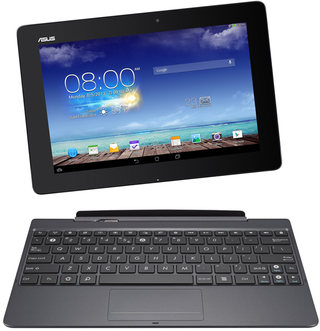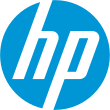Related Research Articles
Archos is a French multinational electronics company that was established in 1988 by Henri Crohas. Archos manufactures tablets, smartphones, portable media players and portable data storage devices. The name is an anagram of Crohas' last name. Also, in Greek (-αρχος), it's a suffix used in nouns indicating a person with power. The company's slogan has been updated from "Think Smaller" to "On The Go", and the current "Entertainment your way".

A tablet computer, commonly shortened to tablet, is a mobile device, typically with a mobile operating system and touchscreen display processing circuitry, and a rechargeable battery in a single, thin and flat package. Tablets, being computers, have similar capabilities, but lack some input/output (I/O) abilities that others have. Modern tablets largely resemble modern smartphones, the only differences being that tablets are relatively larger than smartphones, with screens 7 inches (18 cm) or larger, measured diagonally, and may not support access to a cellular network. Unlike laptops, tablets usually run mobile operating systems, alongside smartphones.

A smartbook was a class of mobile device that combined certain features of both a smartphone and netbook computer, produced between 2009 and 2010. Smartbooks were advertised with features such as always on, all-day battery life, 3G, or Wi-Fi connectivity and GPS in a laptop or tablet-style body with a screen size of 5 to 10 inches and a physical or soft touchscreen keyboard.
The Adam Tablet is a tablet computer designed by Bangalore-based firm Notion Ink Design Labs. The worldwide launch occurred on December 18, 2010 via a video released by Notion Ink detailing their Eden Interface. On December 9 a limited number of devices were released for pre-order globally, followed by a larger pre-order starting January 9, 2011 and an open subscription pre-order from 11 January 2011. The Adam runs a customized version of Android 2.2 Froyo, and has released beta versions of Android 3.0 Honeycomb and Android 4.0 Ice Cream Sandwich The beta versions released were largely done through the efforts of volunteer developers. The Adam is set to be the first Android device marketed to contain Pixel Qi's low-power, dual-mode display. The device is one of several tablet form-factor devices to include a dual-core Nvidia Tegra 2 processor that can support 1080p video output mirroring.
HP Slate is a small line of HP consumer tablets and all-in-ones.

The ViewSonic G Tablet is an Android-based tablet produced by ViewSonic Corporation, a manufacturer and provider of visual technology. It first appeared for consumer purchase at Sears on 1 November 2010.

The HP TouchPad is a tablet computer that was developed and designed by Hewlett-Packard. The HP TouchPad was launched on July 1, 2011, in the United States; July 15 in Canada, United Kingdom, France, Germany; and August 15 in Australia.

The Asus Eee Pad Transformer TF101 is a 2-in-1 detachable tablet developed by Asus that runs the Android operating system. It is the first tablet in the Asus Transformer Pad series. The Eee Pad Transformer features a 10.1-inch (260 mm) display, an Nvidia Tegra 2 dual-core chip, 1 GB of RAM, and 16 or 32 GB of storage. The tablet initially launched with Android 3.1, nicknamed "Honeycomb", but was updated to support Android 4.0.3.

The Toshiba Thrive was a 10.1" tablet computer running Android 3.2.1. PC World praised its full-sized and versatile SD card slot, HDMI port, and USB ports with host functionality and the ability to handle large external drives as well as standard peripherals like USB Keyboards, printers and cameras. The review concluded that there were minor disadvantages including a bulky form and poor sound quality. CNET's review said "Its grooved back, full HDMI and USB support, full SD card slot, and replaceable battery justify its very bulky design."

Chromebook is a line of laptop and tablet computers that run ChromeOS, an operating system developed by Google.

A 2-in-1 laptop, also known as 2-in-1 PC, 2-in-1 tablet, laplet, tabtop, laptop tablet, or simply 2-in-1, is a portable computer that has features of both tablets and laptops.
The Acer Iconia is a range of tablet computers from Acer Inc. of Taiwan.

The Tablet S is a tablet computer released by Sony in September 2011. Featuring a "unique asymmetric design", the Tablet S runs Google's Android 3.2 Honeycomb operating system and features a 9.4 in (240 mm) multitouch display, 1 GHz Nvidia Tegra 2 dual core processor, Wi-Fi ability, front- and rear-facing cameras, Bluetooth, and an infrared sensor. It is also configured with access to the Sony Entertainment Network and is PlayStation Certified and DLNA compatible. Tablet S was Sony's first modern tablet computer. It was succeeded by the Xperia Tablet S, which would be created by Sony's new subsidiary Sony Mobile.
The IdeaPad tablets from Lenovo were a brand of consumer-oriented tablet computers designed for home use or entertainment, as opposed to the business-focused ThinkPad Tablet series. Devices sold in certain countries, such as China, India and New Zealand, were sold under the LePad brand, similar to the LePhone series of smartphones. IdeaPad-branded tablets have been produced with the Android and Windows operating systems.

Lenovo Yoga is a line of consumer-oriented laptop computers, tablets, and all-in-one computers designed, developed and marketed by Lenovo, named for their ability to assume multiple form factors due to a hinged screen. The line currently competes against other 2-in-1 PCs such as the HP Spectre.
The Lenovo IdeaPad Yoga 11 is a hybrid laptop/tablet Windows RT-based computer released in late 2012. The Yoga 11 gets its name from its ability to change form factors thanks to the two-way hinge used to mount its display. It was discontinued on July 17, 2013, due to the poor sales of Windows RT devices.

Surface 2 is a Surface-series Windows RT hybrid tablet computer created by Microsoft. It was unveiled on September 23, 2013, and released on October 22, 2013 and is the successor to the original Surface. As of January 2015, Microsoft no longer manufactures Surface 2, and provided security updates for the device until January 2023. Microsoft's next attempt at a Windows-on-ARM tablet would be the Surface Pro X, released in 2019, six years after the Surface 2.
Surface Mini is an unreleased tablet computer that Microsoft designed as the successor to the Surface 2 in the Microsoft Surface family. The device has a Qualcomm Snapdragon 800 processor and a 7.5-inch (19 cm) 4:3 aspect ratio touchscreen display that defaults to portrait mode. Like its predecessor, the Surface Mini runs Windows RT 8.1, a mobile operating system that was designed for the ARM architecture and has limitations including an inability to install Win32 applications; programs can only be installed from the Windows Store.

The Asus Transformer Pad TF701T is an Android tablet computer made by Asus, successor to the Asus Transformer Pad Infinity. The Transformer design includes a docking keyboard. The Asus Transformer Pad TF701T was released in the UK in October 2013 and in the U.S. in November 2013.

The Nvidia Shield TV is an Android TV-based digital media player produced by Nvidia as part of its Shield brand of Android devices. First released in May 2015, the Shield was initially marketed by Nvidia as a microconsole, emphasizing its ability to play downloaded games and stream games from a compatible PC on a local network, or via the GeForce Now subscription service. As with all other Android TV devices, it can also stream content from various sources using apps, and also supports 4K resolution video. It is produced in two models, with the second Shield TV Pro model distinguished primarily by increased internal storage.
References
- ↑ Kastrenakes, Jacob (June 24, 2013). "HP takes Android to the desktop with Slate 21 all-in-one". The Verge. Archived from the original on February 9, 2019. Retrieved March 6, 2020.
- 1 2 3 4 5 Low, Cherlynn (October 14, 2013). "HP Slate 21 Review". Tom's Guide. Archived from the original on November 20, 2017. Retrieved March 6, 2020.
- 1 2 3 4 Segan, Sascha; Santo Domingo, Joel (October 25, 2013). "HP Slate 21 Review". PC Mag. Retrieved March 6, 2020.
- 1 2 3 4 5 6 Taylor, Alun (November 26, 2013). "HP's ENORMO-SLAB: The Slate 21 MONSTER tablet". The Register. Archived from the original on June 23, 2018. Retrieved March 6, 2020.
- ↑ Oliver, Dave (July 2, 2014). "HP Slate 21 review". Wired UK. Archived from the original on July 2, 2018. Retrieved March 6, 2020.
- ↑ Stein, Scott (January 8, 2014). "HP Slate 21 Pro: Android desktop and PC monitor in one". CNET. Archived from the original on January 28, 2020. Retrieved March 6, 2020.
- 1 2 Brown, Michael (May 8, 2014). "HP Slate 21 Pro review: It's built for business, but it's great for the home". PCWorld. Archived from the original on August 28, 2017. Retrieved March 6, 2020.
